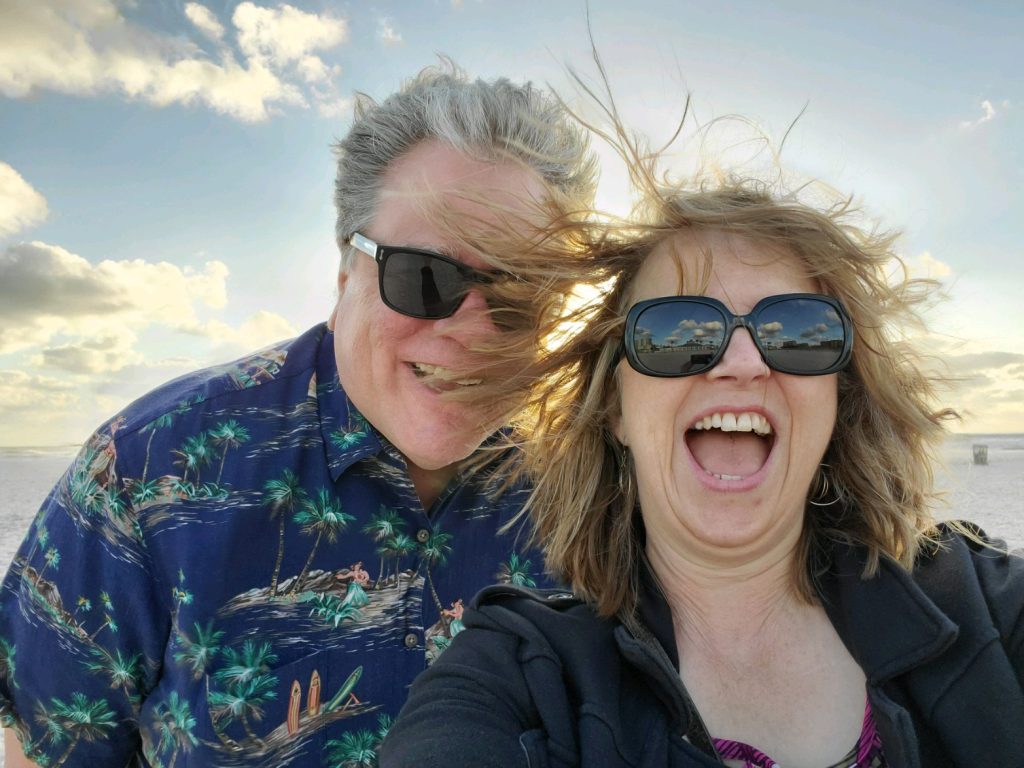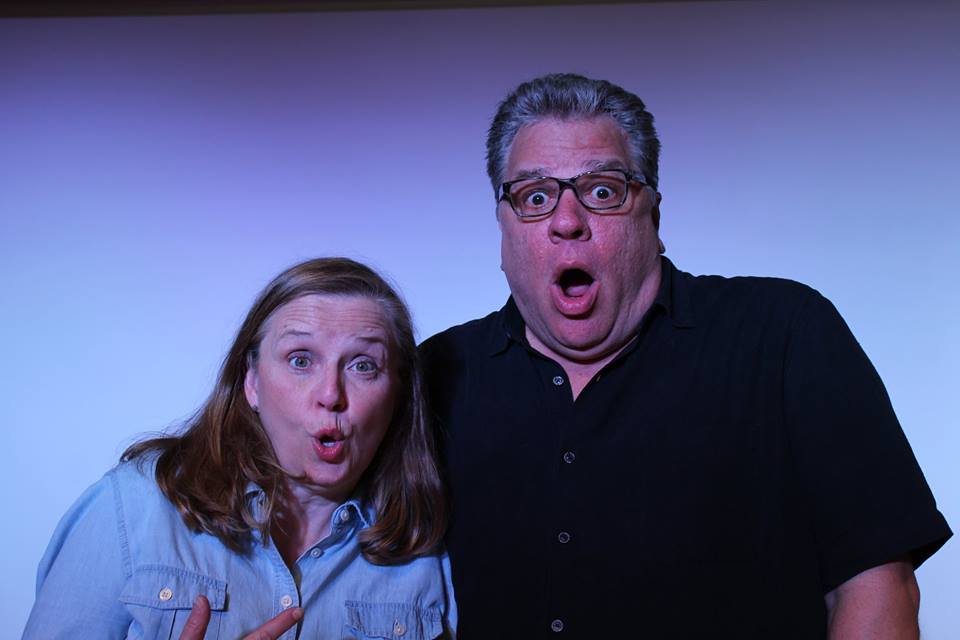Mixed Emojis performs long-form improv that is grounded in reality. Their show features true-to-life characters in familiar (and not-so-familiar) circumstances. Sometimes funny, sometimes poignant, sometimes just stupid.
Kari Ann Stamatoplos, Tony Stamatoplos
Clearwater, Fla.
Schedule
Mixed Emojis will perform in the 7:30 p.m. block at The Commodore on Friday, August 8.
Previous Countdown Improv Festival appearances
2024, 2023, 2020, 2019, 2018
Click here to sponsor Mixed Emojis‘ show at the 2025 Countdown Improv Festival.
Images



Troupe bio
Kari Ann and Tony have been a team offstage for more than 25 years. After improvising in short- and long-form groups for 20 years, they formed the duo, Mixed Emojis in 2017. Their comedy emerges from shared and contrasting perspectives on life and a plethora of interests, obsessions, and idiosyncrasies. They first trained as improvisers with ComedySportz-Indianapolis, where they performed for more than 15 years. They also applied their improv skills in their full-time careers; Kari Ann at the world’s largest children’s museum, and Tony in higher education. Mixed Emojis has performed at: American Stage Theatre (St. Petersburg, FL), A Murder of Shows (at Black Crow Coffee Co. in St. Petersburg), the 2018 and 2019 Countdown Improv Festivals, Let’s Get Real Improv in Sanford, FL, the Gulfport Indie Improv Show (at the Gulfport Arts Center), and for Tampa Downtown Partnership on the Winter Village Express. Tony also has played with house teams at American Stage and The Box Theater (Tampa). Kari Ann and Tony founded Mixed Emojis Comedy and were founders, co-directors, and members of the short-form improv group, Team Comoji.
Interview (from 2019)
We’re so thrilled that you’ll be joining us again for a second year! Your format is loosely based on the television program Antiques Roadshow. Tell us what you like about this format. What’s challenging about it?
We’re thrilled to be back this year. In our format, we love that we can go anywhere. We’re not limited to any particular place or time. We begin with a “base” scene to ground the show, then pop out into other scenes, in which we discover new characters and explore relationships. Most of the show occurs in those other scenes, which can be about anything, though we tie them loosely to the base scene. The suggestion is referenced in some way, but it works best when it’s not strictly about the object.
One challenge is to avoid literally “following the object” we get as a suggestion, and not make it about that rather than the people and relationships surrounding it. The suggestion should just be inspiration for the first scene. This can be an issue with other formats, too. Another challenge can be in getting carried away with that base scene and other scenes situated back at “the program.” These need to be interesting to get things off the ground, but not become the focus of the show. Also, with so many different characters, it’s important to play them strong and definitively, both for the audience and for us. Otherwise, things can get confusing.
What are the benefits of structuring your show around a format that’s familiar to audience members? Is it easier to get buy-in when you’re improvising within the bounds of a structure that audience members already recognize? Do you ever get Antiques Roadshow super fans at your shows?
As far as structure is concerned, all improv occurs within some structure, and yes, we did choose one that would be accessible enough without limiting us too much. Ours also helps us keep the focus on “real” people, not that we don’t venture into some weird places and situations at times. Are there Antiques Roadshow super fans? We’re laughing, imagining what one would be like. We’d love to meet one—we think! If they’re ever at our shows, they haven’t come out as such yet. We’re not sure Antiques Roadshow is familiar to everyone, but that genre of TV show probably is, and it’s been around for a long time. On TV, it has several “scenes,” each with a guest whom a host interviews to get information. When we watch it, we always wonder about the real people, history, and stories surrounding it. The Roadshow structure is really just a catalyst for our show. We could easily structure it around Pawn Stars, Counting Cars, or anything in that genre. In fact, we discussed several of those in the beginning, and may try one in the future. We’re fascinated by formats that begin with a host interviewing a “regular” person, and where that can go. It would be fun to try this with a format based on The Tonight Show, The Late Show, or Meet the Press, with the host interviewing a non-celebrity guest. That’s a variation of our format we might try too. (And we’re working on some ideas for our next format, which we won’t mention here. Stay tuned for that.)
The two of you both performed with ComedySportz for a long time, back when you were living in Indianapolis. How does your ComedySportz experience influence the way you approach long-form?
ComedySportz taught us the basics of improv: Yes, and…, teamwork, give-and-take, facing fears, and so on. In ComedySportz we were called on to play a variety of games and scenes, with very different characters, in several relatively short scenes, all in a single show. Sometimes, we’d do two shows in the same night, as well as remote shows and buy-out shows for different groups. In ComedySportz, we were part of a large stable of players, so we were always varying who we played with, and had to learn to read and adapt to different personalities and styles of play. We also learned different ways to be sensitive to an audience, wanting them to leave feeling satisfied. This is something we definitely could feel after a show. ComedySportz also showed us the importance of having a “brand,” so audiences and potential audiences know what you’re about and what to expect. Of course, then you have to deliver that. After years with ComedySportz, we understand and appreciate the pleasure people get when they’re out having fun, which is both a responsibility and something to shoot for as performers.
Talk about the pros and cons of improvising with your spouse. What’s great about it? What’s challenging about it, if anything?
Because we’ve been in a relationship for more than 25 years, we’ve shared a lot in our lives. We have common history, shared references, and such. It can be easier for us to read one another, though we never want to fall back on inside jokes or anything like that. There’s a comfort level we don’t always have when we play with others. We know and respect our boundaries. We strive for improv that is reality-based. As with any form of theater, we want to come from a place of truth. We draw from a lot of truths we have in common, and it’s normal that those wouldn’t always be comfortable. Our style of improv will reference or touch on real circumstances, experiences, and feelings. That can be tough sometimes. As actors, we make ourselves accept and allow it. This has to do with vulnerability, with one another and with an audience.
We’ve been married for 22 years, and it’s so fun to make the time regularly to literally play together, even being like kids together. The best part is making each other laugh. We feel the audience picks up on this vibe; it adds something extra to what we’re doing, making it more natural and truthful.
A real challenge, frankly, is simply making the time to practice together at home. It’s actually easier sometimes for us to go to scheduled practices of our short-form group or other groups we perform with. There are no distractions of laundry, dishes, bills, etc. You know, life? When we do practice at home, it’s relaxing and a lot of fun, and our cat likes to get in on the act for at least one scene.
In researching this interview, we discovered that the two of you have given presentations on how to use improv as a tool for improving customer service in libraries. We find this fascinating! Can you tell us a little about this?
We’re big proponents of applied improvisation. We enjoy teaching improv principles to people who can use them in business, education, and other parts of their lives. We have not only done this for libraries, but also for the world’s largest children’s museum and a global architecture firm. We both have a lot of experience in customer service in different environments, and always look for ways to improve it. The essence of the training we’ve done, and continue to do, is being able to see one’s customers (or patrons, visitors, etc.) and their experiences from their point-of-view. Incorporating improv is a natural way to do this, and we tailor improv training to whatever group we’re working with. Tony is a career librarian and has applied improv in libraries and university classrooms, and has written and presented professionally about that. Kari Ann worked as a full-time actor/ improviser for a number of years at The Children’s Museum of Indianapolis.
Finally, we’ve gathered that the two of you are big fans of Disney World. We’ve wanted to go for awhile but we’ve found it hard to justify the costs. Any theories on why tickets are so damn expensive? And any tips on how out-of-staters can save money?
We confess! We’re Disney freaks. Admission tickets are expensive. One theory about the cost is simply that they can charge that much because enough people are willing to pay. Another theory is that they intentionally price-out people in certain income brackets, as well as try to control crowd size. If true, neither appears to be successful for Disney fans. You can find discounts and special deals, through AAA, travel agents, or you can just move to Florida (you know you want to). Now, we’re tempted to buy park tickets for you two, to see and hear your reactions and comments. And it might be worth it, just to read a Slate review of the Pirates of the Caribbean or Walt Disney’s Enchanted Tiki Room. Let us know—we make good tour guides!

